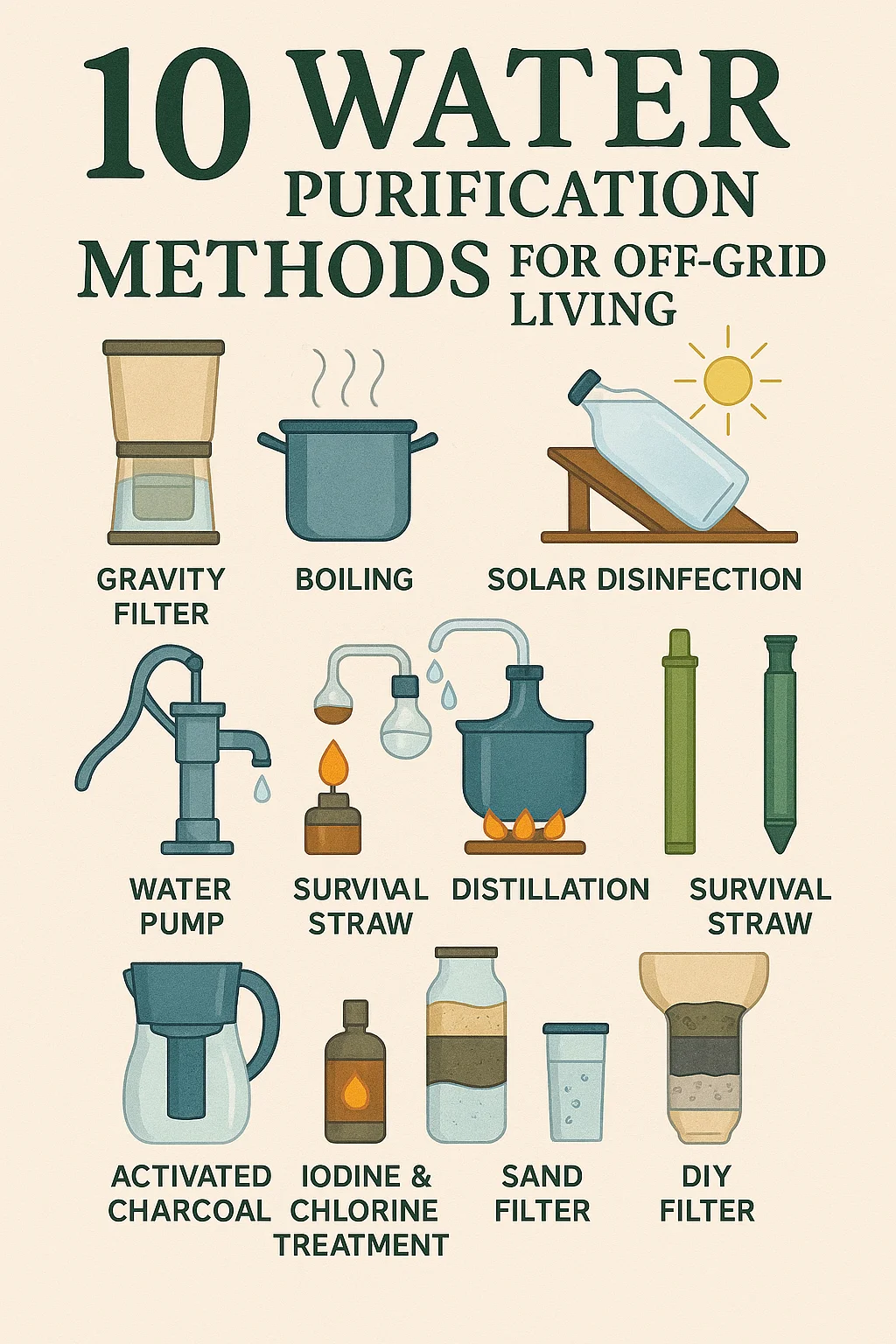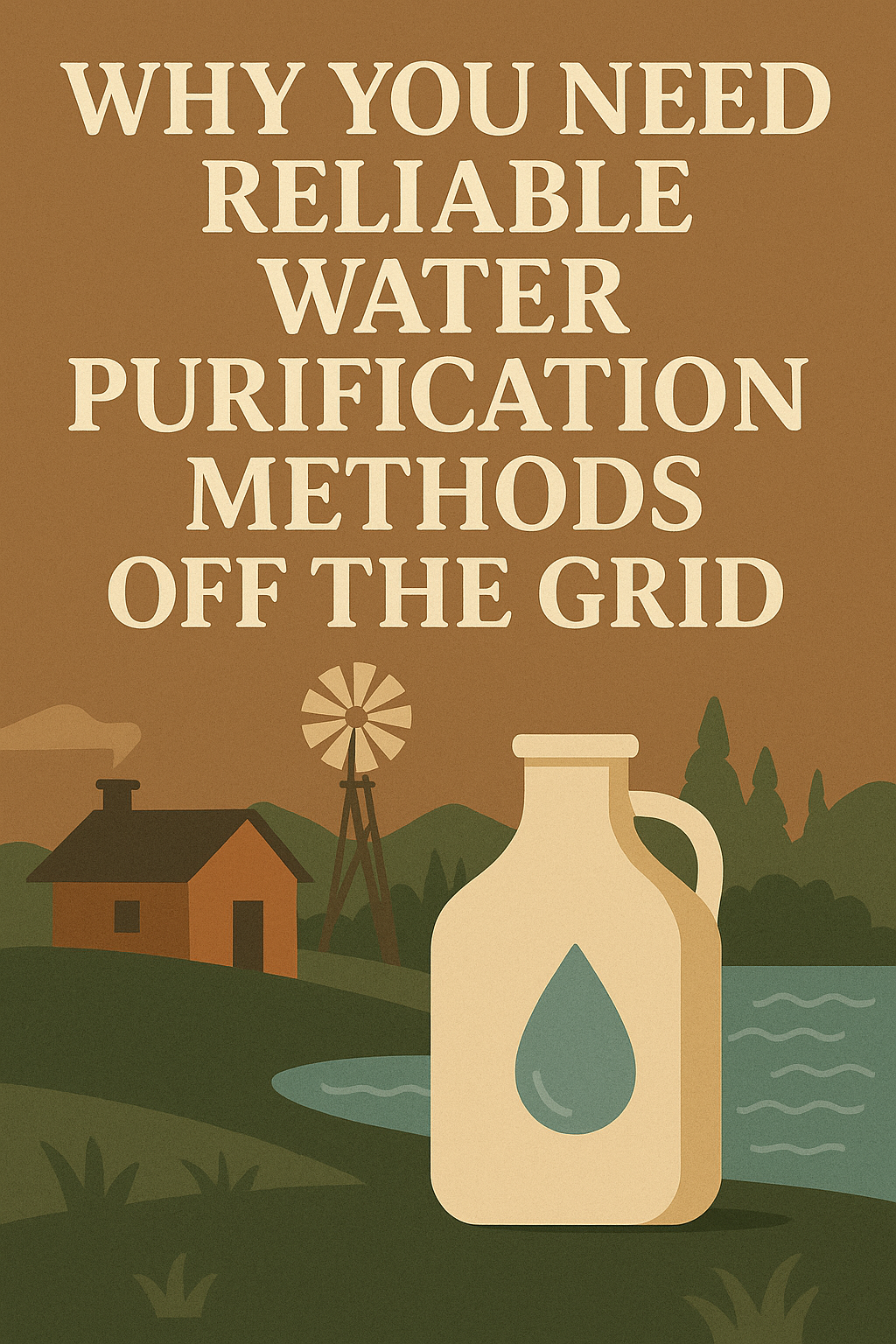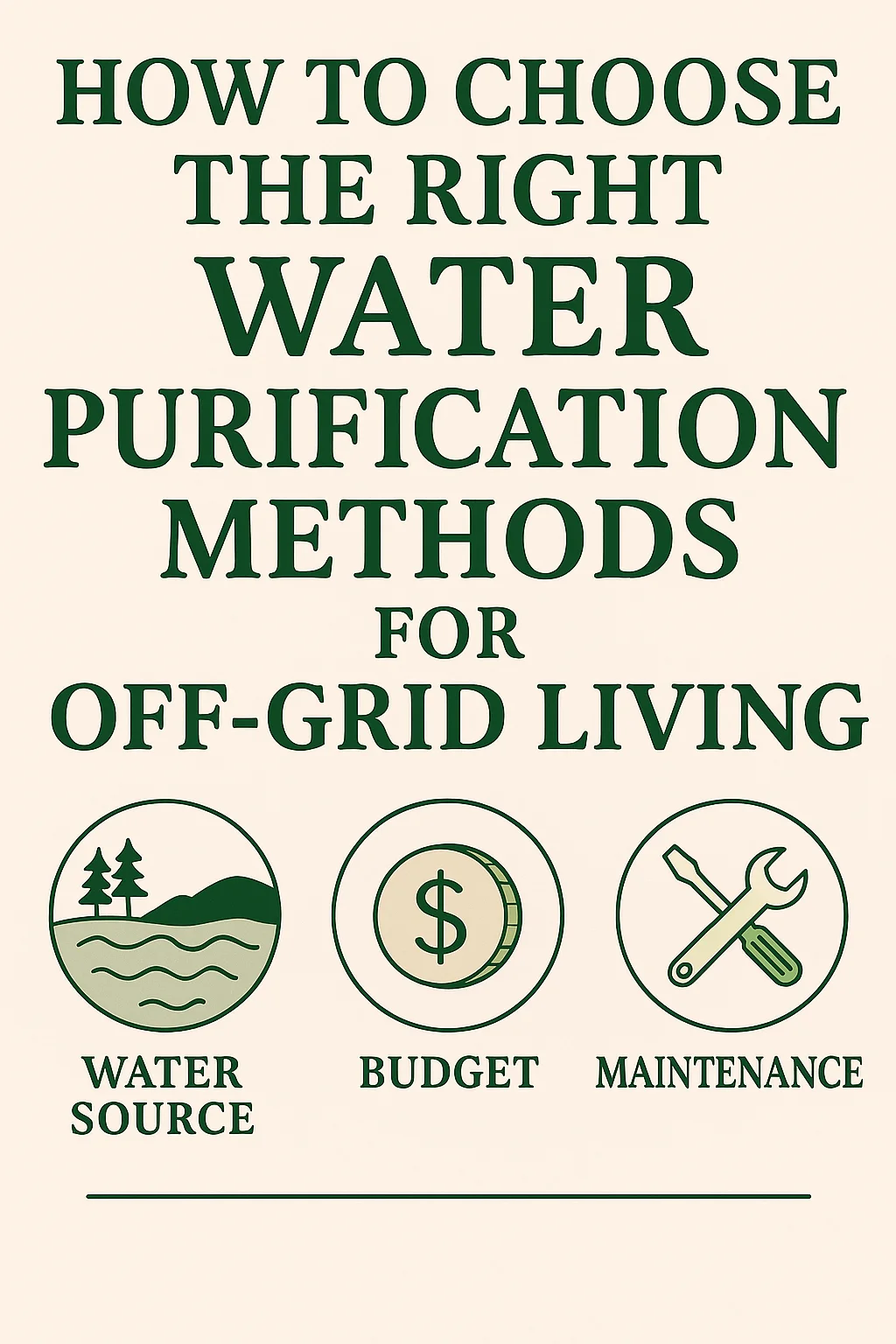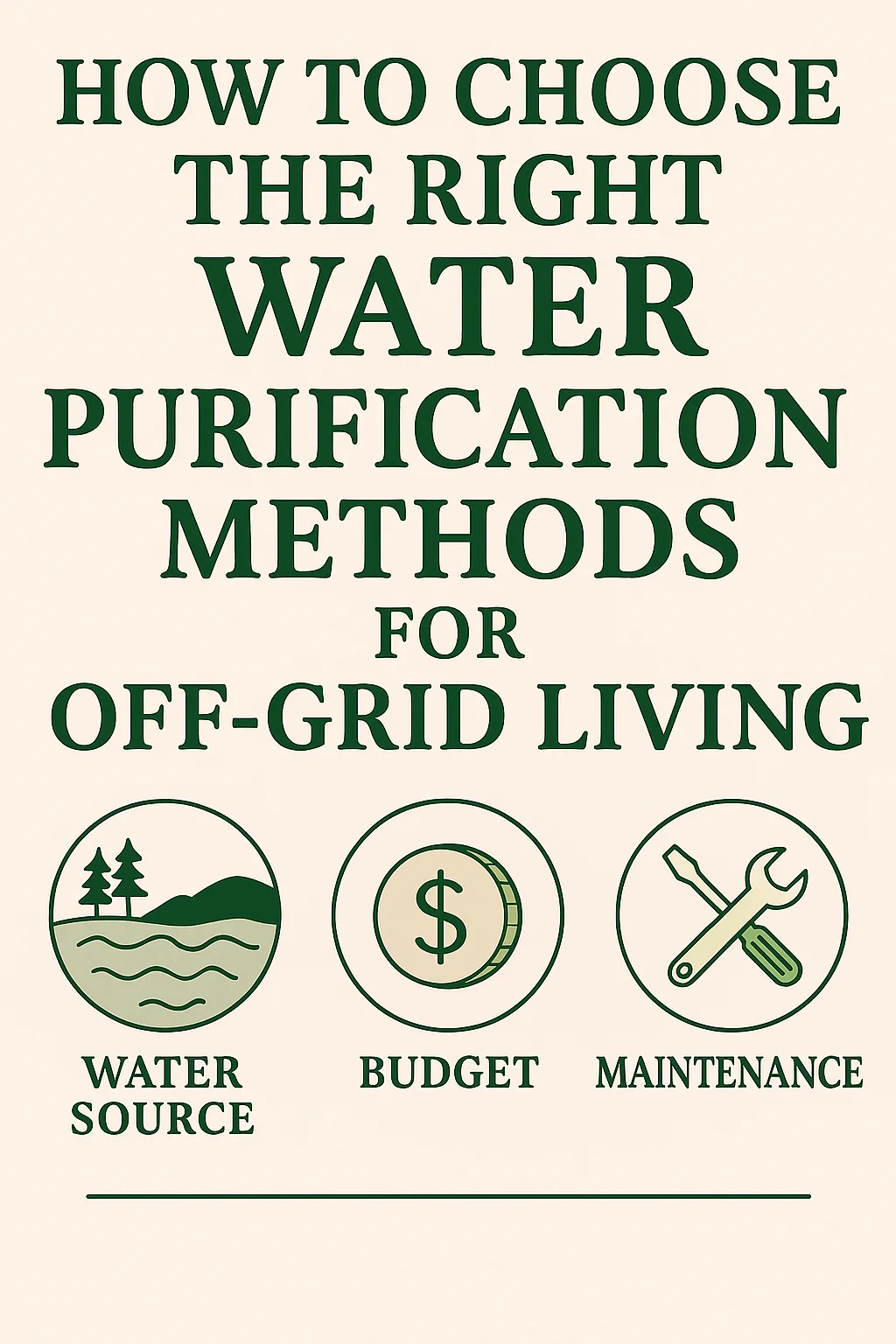Clean Water Off the Grid Isn’t Optional—It’s Essential
Imagine this: you’re living off-grid, harvesting rainwater, or pulling from a nearby stream. The freedom is exhilarating—until you need safe drinking water. When there’s no tap to trust, knowing effective water purification off grid becomes one of your most vital survival skills.

Whether you’re homesteading, camping long-term, or preparing for emergencies, this guide walks you through the 10 most reliable methods of water purification off grid. You’ll learn how to make any water source safe, practical tips for each method, and how to choose the right system for your situation.
Why Water Purification Off Grid Matters More Than Ever

Without city filtration systems, the water you collect—whether from lakes, rivers, rain, or wells—is almost always contaminated. It might look clean, but it could harbor:
-
Bacteria (like E. coli)
-
Viruses (such as Norovirus or Hepatitis A)
-
Parasites (like Giardia or Cryptosporidium)
-
Heavy metals (lead, mercury, arsenic)
-
Chemicals and pesticides
To live sustainably and safely, you need proven, adaptable water purification off grid methods that suit your climate, setup, and mobility.
Top 10 Water Purification Off Grid Methods (At a Glance)

| Method | Removes | Ideal For | Requires Power |
|---|---|---|---|
| Boiling | Bacteria, viruses | Emergencies, campsites | Heat/fire |
| Ceramic Filters | Bacteria, sediments | Homesteads, field use | No |
| Activated Charcoal Filters | Chemicals, taste/odor | Daily use | No |
| UV Light Purifiers | Viruses, bacteria | Travel, bug-out bags | Batteries |
| Distillation | Salts, metals, pathogens | Saltwater, industrial zones | Heat/fire |
| Reverse Osmosis | Most contaminants | Permanent installations | Yes |
| Water Purification Tablets | Bacteria, viruses | Emergency kits | No |
| Solar Disinfection (SODIS) | Microbes | Sunny climates, remote use | Sunlight |
| Sand/Gravel Filters | Sediments | Pre-filtration | No |
| Bio-Sand Filters | Microbes, turbidity | Low-tech permanent use | No |
1. Boiling Water
Boiling is the most accessible off-grid water purification method. All you need is fire and a container.
✅ Benefits:
-
Kills bacteria, viruses, and protozoa
-
Easy to execute anywhere
-
Doesn’t require special tools
⚠️ Drawbacks:
-
Doesn’t remove chemicals or heavy metals
-
Requires fuel or heat source
-
Not scalable for large households
Use this as a first response or a backup when other systems fail.
2. Ceramic Water Filters
Ceramic filters block contaminants using tiny pores in the material. They’re ideal for stationary and portable off-grid setups.
✅ Benefits:
-
Removes bacteria, protozoa, and dirt
-
Durable and long-lasting
-
Works without electricity
⚠️ Drawbacks:
-
Doesn’t remove viruses or chemicals
-
Must be cleaned regularly
For daily off-grid water purification, this is one of the most dependable solutions.
3. Activated Charcoal Filters
Charcoal filters absorb organic contaminants, chlorine, and volatile chemicals. They’re best used alongside other purification methods.
✅ Benefits:
-
Removes bad tastes, odors, and some chemicals
-
Easily integrated into gravity-fed systems
-
Improves water clarity
⚠️ Drawbacks:
-
Doesn’t kill microbes
-
Needs frequent cartridge replacement
These are great for improving water quality after disinfection.
4. UV Light Water Purifiers
UV pens and bottles use ultraviolet light to sterilize water quickly. Perfect for minimalist setups and bug-out bags.
✅ Benefits:
-
Kills bacteria, viruses, protozoa
-
Quick (treats water in under 2 minutes)
-
Compact and travel-ready
⚠️ Drawbacks:
-
Doesn’t remove dirt or chemicals
-
Requires batteries or solar charging
One of the fastest water purification off grid tools available today.
5. Distillation
Distillation turns water into vapor, then condenses it back—leaving most contaminants behind.
✅ Benefits:
-
Removes salts, heavy metals, pathogens
-
Works with seawater and polluted water
-
Reliable if heat is available
⚠️ Drawbacks:
-
Energy-intensive
-
Slow and equipment-heavy
For long-term setups in coastal or contaminated areas, distillation is a lifesaver.
Want a reliable way to turn any off-grid water source into clean, drinkable water without needing electricity?
👉 Consider adding a gravity-fed system or solar-powered purifier to your setup. These options work even in remote areas—and they’re easier to maintain than you think
6. Reverse Osmosis (RO)
Reverse osmosis uses pressure to force water through a membrane, leaving impurities behind.
✅ Benefits:
-
Removes virtually all contaminants
-
Great for heavily polluted water
-
Available in compact or full-home systems
⚠️ Drawbacks:
-
Needs power and water pressure
-
Wastes some water during process
Use RO as part of a permanent, solar-powered off-grid water system.
7. Water Purification Tablets
Compact and effective, tablets are a staple in survival kits for a reason.
✅ Benefits:
-
Lightweight and travel-ready
-
Kills viruses, bacteria, and protozoa
-
Inexpensive and shelf-stable
⚠️ Drawbacks:
-
Doesn’t remove particles or toxins
-
Chemical taste
-
Limited to emergency use
Great for immediate treatment in disaster or escape scenarios.
8. Solar Water Disinfection (SODIS)
Using sunlight and clear bottles, SODIS kills pathogens over time—especially in equatorial or desert areas.
✅ Benefits:
-
Free and renewable
-
Very low-tech and accessible
-
Useful in warm, sunny regions
⚠️ Drawbacks:
-
Requires 6–12 hours of strong sun
-
Limited volume and cloudy water not ideal
An excellent off-grid purification backup for those relying on solar energy.
9. Sand and Gravel Filters
Layered filtration through sand and gravel removes physical debris and turbidity.
✅ Benefits:
-
Simple to build and maintain
-
Perfect pre-treatment step
-
No chemicals or energy needed
⚠️ Drawbacks:
-
Doesn’t kill or filter microbes
-
Requires frequent cleaning
Use this before UV, boiling, or tablets to increase effectiveness.
10. Bio-Sand Filters
These improve on regular sand filters by using a bio-layer that naturally eliminates pathogens.
✅ Benefits:
-
Removes bacteria, protozoa, and sediment
-
No electricity or chemicals needed
-
Long-term solution for off-grid homes
⚠️ Drawbacks:
-
Slow flow rate
-
Requires set-up time for bio-layer to develop
For permanent off-grid dwellings, bio-sand filters are a reliable, sustainable choice.
How to Choose the Right Off-Grid Water Purification Method
Not all water sources—or living setups—are the same. Here’s how to pick the best method:

| Factor | Why It Matters |
|---|---|
| Water Source | Is it a stream, pond, well, or rainwater? |
| Contamination Risk | Do you expect microbes, metals, or both? |
| Power Availability | Can you use solar, fire, or batteries? |
| Portability | Are you traveling or in a fixed location? |
| Budget | Do you want low-cost short-term or high-end long-term? |
Most people use 2–3 water purification off grid methods together for maximum security.
Smart Combinations for Off-Grid Water Safety
Layering your purification steps dramatically improves safety and efficiency.
-
Sand Filter → Charcoal → UV Light
-
Sediment Filter → Ceramic → Boiling
-
Pre-filter → RO System → Carbon Polishing
-
Tablets → Solar SODIS (sun backup)
This tiered approach keeps your water clean in any weather or emergency.
Recommended Resource: The AquaTower
If you’re serious about securing clean water off the grid, The AquaTower is a game-changer.
This expertly designed system is built for:
-
Sustainable off-grid living
-
Long-term water purification
-
Minimal maintenance
-
No power required
Perfect for homesteaders, preppers, or anyone living remotely, The AquaTower filters bacteria, sediment, and harmful contaminants from even the dirtiest water sources. It’s an ideal addition to your emergency kit or everyday use.
👉 Click here to learn more about The AquaTower system and take a critical step toward full water independence.
FAQ – Water Purification Off Grid
Can I rely on just one purification method off grid?
You shouldn’t. Combining filtration and disinfection ensures complete protection.
What’s the best off-grid method for beginners?
Ceramic gravity filters paired with charcoal are low-maintenance and beginner-friendly.
Do tablets remove toxins or heavy metals?
No. Tablets kill pathogens but don’t filter chemicals or particulates.
Is UV purification safe and effective?
Yes, as long as the water is clear and you have a reliable power source.
Can I build my own water filter off grid?
Absolutely. DIY sand/charcoal filters are popular among homesteaders and preppers.
Conclusion: Mastering Water Purification Off Grid Means Mastering Survival
You can go without power. You can adapt without convenience. But you can’t survive without clean water. That’s why having multiple reliable methods for water purification off grid isn’t optional—it’s your foundation.
Whether you’re collecting rain, tapping a stream, or melting snow, having a proven purification method gives you control over your health and safety.
💧 Don’t leave it to chance—invest in tools that guarantee safe water wherever you are.
Start with The AquaTower and build your off-grid water system with confidence.

